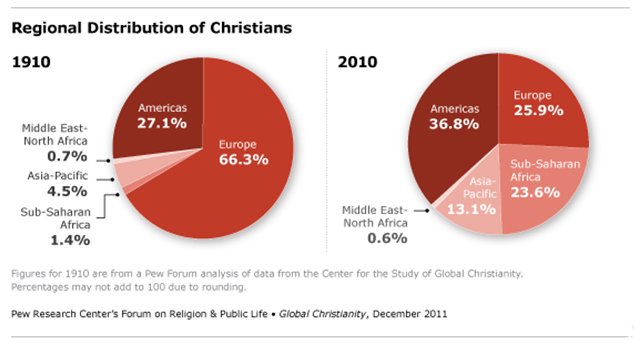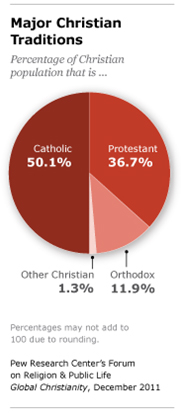17 September 2012
Should We Be So Negative About Christianity's Supposed Decline? Recent Research into World Figures
by Dr Mark Keown
It is easy to be negative about the state of the church and the seeming decline of Christianity, especially if we are myopically focussed on our own situations. However, a recent study of the last 100 years of Christian growth shows that the global situation is far from demoralising – in fact, Christianity remains easily the world’s strongest religion, has expanded dramatically in Asia and especially Africa, remains strong in the west, and has seen a dramatic spiritual awakening.
Indeed, the recent Pew Forum study is fascinating (their studies are great, check them out at the link at the end of this blog). The figures are not perfect, based on census and other national figures, so are not exact and do not account for nominalism, syncretism or groups like the Jehovah’s Witnesses and Mormons. However, they are most interesting and show that Christianity is truly global, has exploded in Africa, and, despite claims, is far from dead in the western world.
A 2010 study has shown that the number of Christians in the world has gone from around 600m in 1910 to 2.18b in 2010. The proportion of Christians per overall population remains pretty consistent, 31.5% in 1910 to 35% today. While the ethnicity of Christians has become more diverse, Christianity is not declining, remaining the “largest tree in the garden” with Islam second (1.6b), around 23.4% of the world population. This is encouraging in that Christianity is not dying as some claim. It is challenging because there remains so much work to do.
The distribution of Christians has changed dramatically in the last 100 years so that the faith is now truly global. In 1910, 66.3% of Christians were in Europe and 27.1% in the Americas; a total of 93.4% of world Christians in these two continents. There were few Christians in the Asia-Pacific region (4.5%) and sub-Saharan Africa (1.4%). Now, Christians are distributed across the whole world with no real geographical centre for the faith: 26% in Europe, 37% in the Americas, 24% in sub-Saharan Africa and 13% in Asia and the Pacific.
As the pie graphs below show, the last hundred years has certainly seen an astonishing transformation in global Christianity. The only area which has seen little change is the Middle East and North Africa which remain dominated by Islam.

While the majority of global Christians still live in Europe and the Americas (63%), this is down from 93% in 1910. Whereas Europe in 1910 was 95% Christian, it is now 76% Christian. In the Americas in a hundred years it has dropped from 96% to 86% . Yet, while these numbers do show a decline, they also show that Christianity is far from a spent force in the western world. We can be greatly encouraged by this and continue to rise to the challenge of evangelism in our contexts.
In the Asia-Pacific region Christianity has grown from 3% to 7%. When one considers the massive populations in Asia, this is strong growth. All indications are that this area will be the scene of the most dramatic growth in coming decades. The most dramatic change is in sub-Saharan Africa, where the percentage of Christians has gone from 9% in 1910 to 63% in 2010. That is, the number of Christians in this region has gone from 9m in 1910 to over 516m in 2010. One can say that the gospel has truly exploded in sub-Saharan Africa.
 Breaking down the numbers further, just under half (48%) of the world’s Christians live in ten countries: USA, Brazil, Mexico, Russia, Philippines, Nigeria, China, DR Congo, Germany and Ethiopia.
Breaking down the numbers further, just under half (48%) of the world’s Christians live in ten countries: USA, Brazil, Mexico, Russia, Philippines, Nigeria, China, DR Congo, Germany and Ethiopia.
The denominational make-up of Christians is interesting with half the world’s Christians Catholic, 37% Protestant, and 12% Orthodox. Fringe groups like the Mormons and Jehovah’s Witnesses make up only 1% of “Christians.”
The Pentecostal and Charismatic portion of the global church has exploded from virtually nil at the birth of the Pentecostal movement at the start of the 20th century to 279m Pentecostals and 305m Charismatics in the world. This means that Pentecostals and Charismatics make up 26.7% of global Christians and 8.5% of the world population. Is it fair to say that this is an astonishing spiritual revival? Evangelicals make up 13.1% of the world Christian population, and 4.1% overall. Combined with Charismatic and Pentecostal figures, 39.8% of Christians are Pentecostal, Charismatic or evangelical, around 12.6% of the world’s population.
You can access this study with more figures and full reports at http://www.pewforum.org/Christian/Global-Christianity-exec.aspx.
What do you take from this material? What should we be thankful for? What are our challenges?
